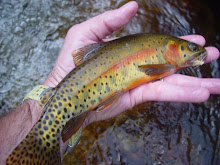It didn't take long to verify a decent brookie population in this stream, both above and below the limestone fines dump, but again no photographic proof. With visual verification of the first two streams on my list, I headed back to camp to wait on my company.
While I waited the rain arrived, so I took temporary shelter under the rear hatch of my vehicle. Shortly after the rain started, my friends arrived and we discussed our plans with the current weather conditions. But first I had to explain my gear situation, take a few laughs, and ask for some gear to loan. After everyone was done laughing at me, we all loaded into my vehicle and headed off the mountain to another stream.
While we were in route the rain stopped and by the time we had reached our destination the skies had actually turned to blue. Once at our destination, we cobbled together an outfit for me and what an outfit it was - a 4ft, one-piece bamboo with an old Pflueger Medalist reel!
 With the fishing slow and nearing dinnertime, we headed back to camp to grab a bite to eat before hitting another stream.
With the fishing slow and nearing dinnertime, we headed back to camp to grab a bite to eat before hitting another stream.The next stream is where I learned to fish for brookies, it is also where both of my kids caught their first brookie, and where my son caught/landed a brookie on video just a week before.
We hiked down the remnants of an old narrow-gauge railroad bed, left from the logging industry of the early 20th century. When the trail disappeared, we decided it was a good location to start fishing. I picked up three fish quickly in the first two pockets - a good start.
I also recently learned that my underwater video camera also takes super macros. This would be a good place to try the newly discovered mode; I think they turned out decent.
 The fishing continued to be good for the remainder of the afternoon, for two of the three of us. My friend with the most experience on this stream (no names to protect the guilty) went back to camp with the smell of skunk.
The fishing continued to be good for the remainder of the afternoon, for two of the three of us. My friend with the most experience on this stream (no names to protect the guilty) went back to camp with the smell of skunk.After a good days fishing and armed with a story of forgotten gear, we decided to head off the mountain again. We would head for the Elk to meet additional WVAngler members and watch the evening hatch. The hatch did not last long, but when the Isonychia spinners appeared they were very heavy.
We watched until well after dark before heading to the Elk River cabin where the remainder of our group was staying. It was an excellent evening of stories and laughter!
The next day started early when the rain beating on my tent woke me shortly after 6:00 AM. Saturday was West Virginia day and the scheduled date of the Elk River clean up, but before the clean-up started I had time to explore another stream.
The stream enters the Elk at this landmark:
 The water was low and the pockets small, you can see in the above photo there wasn't much water. I continued up the trickle and the sound of moving water grew louder as I continued upstream. After less than a quarter-mile I ran into the source of the moving water and at this point the gradient of the stream changed SIGNIFICANTLY.
The water was low and the pockets small, you can see in the above photo there wasn't much water. I continued up the trickle and the sound of moving water grew louder as I continued upstream. After less than a quarter-mile I ran into the source of the moving water and at this point the gradient of the stream changed SIGNIFICANTLY.  What I also found was a good bit of this water was tumbling down and straight underground - the reason for the lack of water near the mouth.
What I also found was a good bit of this water was tumbling down and straight underground - the reason for the lack of water near the mouth.
 After I released the brookie, I noticed a trail above me, which seemed a fitting opportunity to head out. I'm not sure one brook trout constitutes a population, but with the reports I have received I have to believe the population is in good shape.
After I released the brookie, I noticed a trail above me, which seemed a fitting opportunity to head out. I'm not sure one brook trout constitutes a population, but with the reports I have received I have to believe the population is in good shape.
Next on the agenda was the clean up. There were probably 20-30 people in attendance and we were able to clean a couple of miles of stream and road. The stream happened to be in good shape and we finished earlier than planned. The agenda also included lunch, which would consist of BBQ ribs and chicken. I had not been to the clean up in a couple of years but I do remember how good those ribs were. They did not disappoint this year either, they were probably the best ribs I have had anywhere!
Following lunch, I planned to hike into the upper reaches of the Elk where the only access for over four miles is by foot. My destination would be a little over two miles in via the remnants of a railroad track and another new stream for me. Again, I would be solo and when I go solo my mind tends to wander. As I traveled along the tracks and sometimes through a "tunnel" of underbrush, my mind thought of bears and rattlesnakes. I don't know why, I am not the least bit afraid of snakes, but when I caught a glance of movement I jumped back. When I gathered and verified the movement, I was embarrassed to have been scared by a common garter snake!
I calmed down and continued up the tracks, about fifty minutes of total hike time. Another thought that crossed my mind on multiple occasions is how nice the fishing pack hydration bladder (back home in the garage) would be.
Using the GPS I found my destination but first I had to cross the main stream - I hope the rain doesn't swell the river while I'm over there.
I started fishing immediately after I got under the canopy and quickly picked up a couple of brookies.
 I continued upstream until I ran into this wonderful site. The stream was low gradient to this point so this came as a surprise (although I was told to look for it).
I continued upstream until I ran into this wonderful site. The stream was low gradient to this point so this came as a surprise (although I was told to look for it).
 After climbing up and around the falls the gradient changed, not as significantly as the stream from the early morning, but it definitely changed. What also changed was the fish population. Typically a set of falls of that magnitude would act as a fish barrier for invasives and protect the native population. You can understand my amazement when the first fish I picked up was this guy.
After climbing up and around the falls the gradient changed, not as significantly as the stream from the early morning, but it definitely changed. What also changed was the fish population. Typically a set of falls of that magnitude would act as a fish barrier for invasives and protect the native population. You can understand my amazement when the first fish I picked up was this guy.  As I climbed upstream, I continued to pick up little rainbow after little rainbow - in nearly every pocket. The only other place I have fished with a population of little, wild rainbows like this was back in 2005 on the Middle Prong of the Little River in Great Smoky Mountain National Park. The recent droughts had obviously not affected these little guys!
As I climbed upstream, I continued to pick up little rainbow after little rainbow - in nearly every pocket. The only other place I have fished with a population of little, wild rainbows like this was back in 2005 on the Middle Prong of the Little River in Great Smoky Mountain National Park. The recent droughts had obviously not affected these little guys! I continued to climb up this beautiful little stream, with moss-covered boulders and beautiful little plunge pools, all the while picking up little rainbows in nearly every pocket. Had it not been another solo adventure and a limited amount of water I could have fished this stream for an entire day. But again, caution got the better of me and I decided to head back out giving me plenty of time to get back to the vehicle before dark.
I continued to climb up this beautiful little stream, with moss-covered boulders and beautiful little plunge pools, all the while picking up little rainbows in nearly every pocket. Had it not been another solo adventure and a limited amount of water I could have fished this stream for an entire day. But again, caution got the better of me and I decided to head back out giving me plenty of time to get back to the vehicle before dark.



Rainbow Trout Par Marks
 The next morning would not be as early and it would not include rain. It was early enough to get in a little fishing before making the long journey home.
The next morning would not be as early and it would not include rain. It was early enough to get in a little fishing before making the long journey home.First on my list was one of the new streams I had been on Friday morning armed only with a camera. This time I would have a rod and I would get video proof of the brook trout population.

 I fished for about fifteen minutes and nearly hit double-digits. I would say the population in this stream is doing just fine.
I fished for about fifteen minutes and nearly hit double-digits. I would say the population in this stream is doing just fine.I had time for one more new stream on the way home. I had never fished it, but my fishing partner had grown up in this watershed.
Once we found the stream (apparently it had been quite a while since he fished there) it didn't take long to find the brookies.
 Again, in just a short few minutes on the stream we were able to verify a healthy population of brook trout. With this final new stream under my belt, it was time to call it a weekend and head for home.
Again, in just a short few minutes on the stream we were able to verify a healthy population of brook trout. With this final new stream under my belt, it was time to call it a weekend and head for home.
The final weekend tally:
- Five new streams fished
- Brook trout caught in 4 new streams
- Wild browns and rainbows in 2 new streams
- All three species of stream-born trout caught
I also spent time with some great old friends and made a few new ones. It was a wonderful West Virginia weekend!
I have traveled five of the last six weekends and I am burnt out on driving, so I think I'll take a couple of weeks off.
Chris
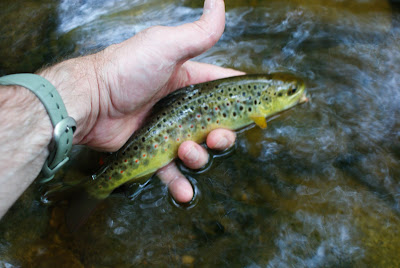 I missed one more strike before we were again on the trail in search of our partner. Again, we found another nice looking run but no fishing partner. By this point I was done looking for anyone, Ross and I were ready to concentrate on fishing. We fished through several nice looking runs and all I could produce was one small brook trout.
I missed one more strike before we were again on the trail in search of our partner. Again, we found another nice looking run but no fishing partner. By this point I was done looking for anyone, Ross and I were ready to concentrate on fishing. We fished through several nice looking runs and all I could produce was one small brook trout.
 I have been told the common name is Hemlock Varnish Shelf and the photos do not do the actual colors justice.
I have been told the common name is Hemlock Varnish Shelf and the photos do not do the actual colors justice. As we neared the trailhead Chad decided to do a little more fishing while Ross and I headed back to camp. When we returned to camp, we found another pleasant surprise. The Forest Service employees had gone and cut us enough firewood to supply us for a week's worth of fires!
As we neared the trailhead Chad decided to do a little more fishing while Ross and I headed back to camp. When we returned to camp, we found another pleasant surprise. The Forest Service employees had gone and cut us enough firewood to supply us for a week's worth of fires! 
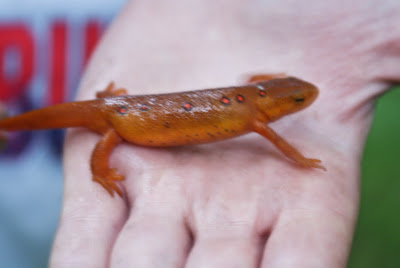 When Chad returned to the car he reported good numbers of the wild browns while I reported good numbers of yellow and lime sallies.
When Chad returned to the car he reported good numbers of the wild browns while I reported good numbers of yellow and lime sallies.



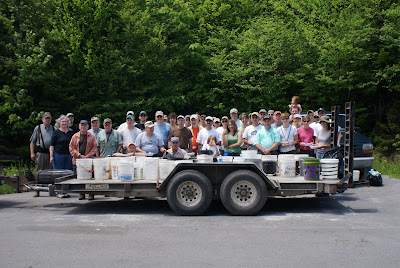



 When I returned to the vehicle I was told I could have taken a much easier photo of the azaleas across the road on the edge of the wood line. Thanks for pointing that out ahead of time.
When I returned to the vehicle I was told I could have taken a much easier photo of the azaleas across the road on the edge of the wood line. Thanks for pointing that out ahead of time.

 This would be the second stream of the weekend to support both native brookies and wild, reproducing brown trout.
This would be the second stream of the weekend to support both native brookies and wild, reproducing brown trout.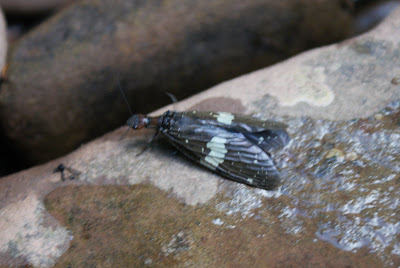 We decided to try our luck on downstream, but we would not have the same luck as Chad had the evening before. We each moved a few fish and I missed a decent little brown, probably in the 12" - 14" class. While we were moving upstream, we had to continue to wake Ross as he was trying to take a nap on the streamside rocks.
We decided to try our luck on downstream, but we would not have the same luck as Chad had the evening before. We each moved a few fish and I missed a decent little brown, probably in the 12" - 14" class. While we were moving upstream, we had to continue to wake Ross as he was trying to take a nap on the streamside rocks. As usual when fishing with Ross, he wants to be the one to release anything caught.
As usual when fishing with Ross, he wants to be the one to release anything caught. After this fish we called it a day....a long, rewarding day.
After this fish we called it a day....a long, rewarding day. 


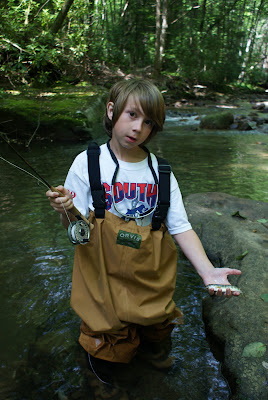 After Ross landed a couple of brookies he became the expert, offering advice to Chad and me. It was the most Ross had talked all weekend and he even let me catch one.
After Ross landed a couple of brookies he became the expert, offering advice to Chad and me. It was the most Ross had talked all weekend and he even let me catch one. 


